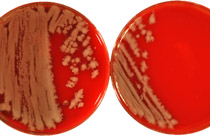Speziallabor für hochpathogene mikrobielle Erreger
Konsiliarlabor für Bacillus anthracis, Francisella tularensis, Yersinia pestis und humanpathogene Vibrionen
Im Fachgebiet ZBS 2 werden klinische Proben und Umweltmaterialien von ausgewählten bakteriellen Pathogenen der Risikogruppen 2 und 3, insbesondere von Erregern, die für biologische Gefahrenlagen bedeutsam sein könnten, diagnostiziert. ZBS 2 stellt auch das Konsiliarlabor für Bacillus anthracis (Milzbrand), Francisella tularensis (Tularämie), Yersinia pestis (Pest) und humanpathogene Vibrionen (Cholera und Infektionen mit Nicht-Cholera Vibrionen).
Die Einsendung von Proben sollte nur nach telefonischer Rücksprache erfolgen.
Diagnostisches Spektrum | Erreger | Kultur u. Antibiogramm* | PCR | Antikörpernachweis | Typisierung und Nachweis Choleratoxin* |
|---|
| Bacillus anthracis (Anthrax, Milzbrand) und andere verwandte Anthrax-Erreger | x | x | x | - |
| Francisella tularensis (Tularämie, Hasenpest) | x | x | x | - |
| Yersinia pestis (Pest) | x | x | x* | - |
| Burkholderia mallei (Rotz) | x | x | x* | - |
| Burkholderia pseudomallei (Melioidose) | x | x | x | - |
| Brucella spp.(Brucellose) | x | x | x* | - |
| Coxiella burnetii (Q-Fieber) | - | x | - | - |
| Vibrio cholerae (Cholera) | x | x | - | x |
* kein akkreditiertes Nachweisverfahren
Differentialdiagnostische Hinweise können unter Anwendung der MALDI-TOF Massenspektrometrie ermittelt werden (in Zusammenarbeit mit Fachgebiet ZBS 6).
nach oben







